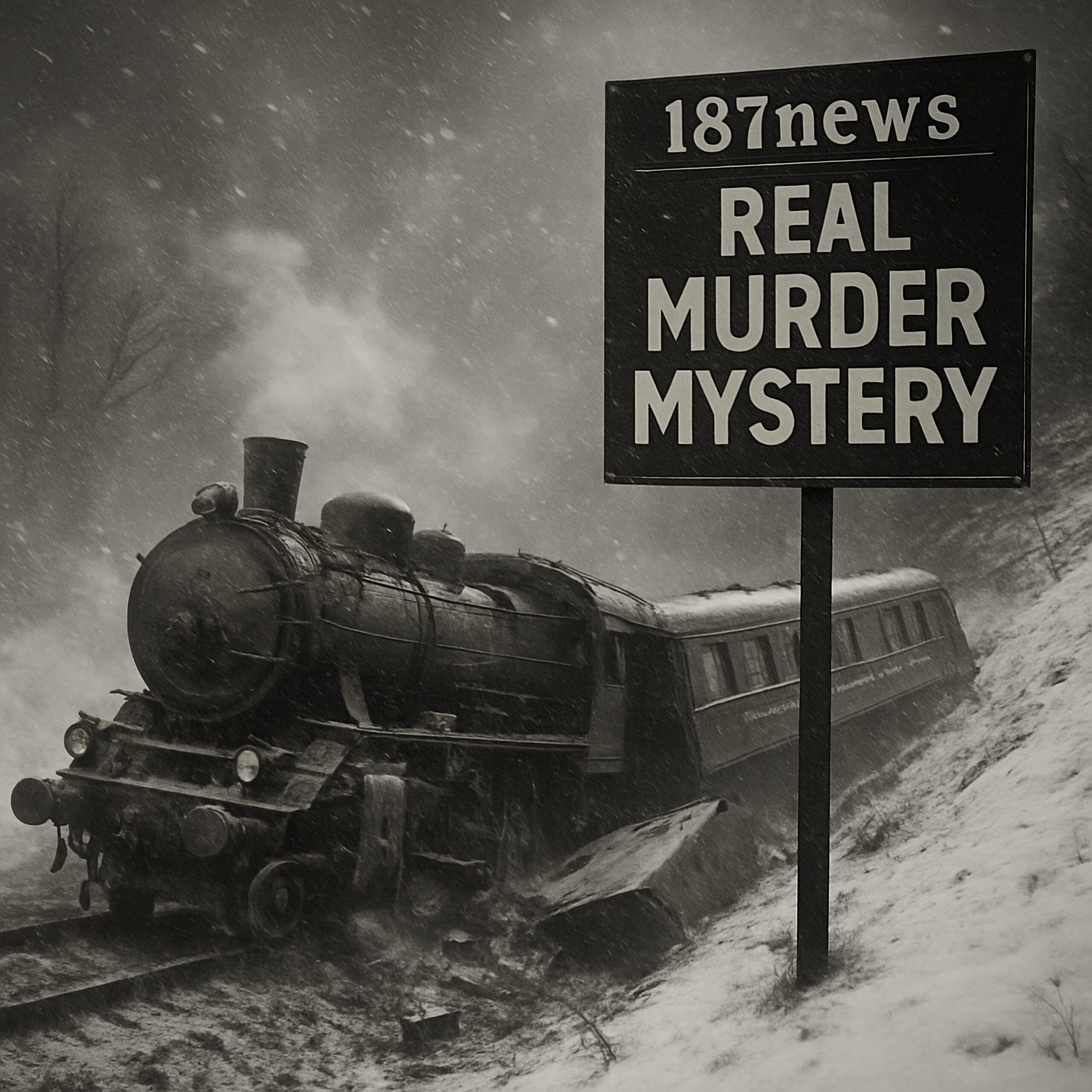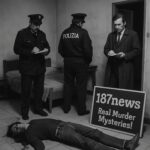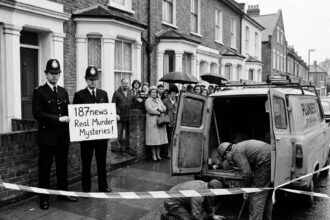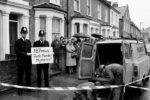A spectacular attack on the luxury train “Wien-Ostende-Express,” which ran daily from Vienna to Ostend, took place on April 10, 1934. On that day, which saw heavy sleet and storm gusts, the express train from Vienna left Linz Central Station at around 1:15 a.m., a few minutes late. To make up for the delay, the train driver Anton Allmer accelerated to 90 kilometers per hour until he suddenly heard a loud bang between the villages of Niederbachham and Mitterbachham. The locomotive had jumped off the tracks and overturned, and the two mail cars behind it, weighing several tons, had collided and slid down the 2.5-meter-high embankment. Fortunately, the rear part of the train with the sleeping cars and the eight express train cars had only become wedged, but the mail cars were wrecked. A total of over 30 people were injured, some seriously, and one fatality was reported. The victim was the stoker Ludwig Ranzenberger, who had been crushed by the coal. How could this disaster have happened? Officials from the Hörsching gendarmerie station investigated this question. Shortly after the accident, the federal authorities cordoned off the scene. Investigators quickly determined that the railway line had been sabotaged by removing a 25-meter-long section of track from the track bed. The train accident was therefore not an accident, but was caused deliberately. But why? Was this a political statement by the rising National Socialists? Although the investigation was in full swing, there were no hot leads for months. Until September, when a man came forward to the police. While cleaning up the dry bed of a mill stream not far from the train accident site, he had observed an unknown man feverishly searching for something in the stream bed. When he spoke to him, the man fled in panic, leaving his bicycle behind. It turned out to be stolen, having been taken from a farmer in the area by a man. When the police searched the stream, they found pliers and socket wrenches. These tools had been used to loosen the nuts on the railroad tracks. Then more than two years passed without any clues as to the perpetrator or perpetrators of the train disaster, until a coincidence came to the aid of the police. On December 19, 1936, police officer Martin Krottenauer from the Weißkirchen station was making his usual rounds at around 5 a.m. when he noticed a man on a bicycle without lights riding onto a bridge. As he approached, he noticed an iron bar sticking out of the man’s backpack. He stopped the cyclist and asked to see his identification. The man reached into his right trouser pocket, but not to take out his ID; instead, he pulled out a revolver and immediately fired at the stunned police officer. Then he fled. Krottenauer fired at the fleeing man, but missed. Krottenauer had suffered a gunshot wound to his upper arm during the shooting. But he remembered the man, whom he had seen just a few days earlier in the Traunauen wetlands together with the forester from Weißkirchen. The forester was questioned about the man, who turned out to be his assistant, Alois Strigl. The middle-aged man was a trained bricklayer who was unemployed and financed his livelihood through theft. After receiving this information, the officers paid a visit to Alois Strigl, in whose apartment they found stolen goods and burglary tools. Under the overwhelming weight of evidence, Alois Strigl confessed that he had been committing burglaries for several years together with Josef Scheinecker, a factory worker from Linz and a trained saddler. This was also the case on December 19, 1936, when they broke into the parish house in Sipbachzell. On his way back, he ran into police officer Martin Krottenauer, whom he then shot. During the subsequent interrogations, it emerged that the burglar duo was also responsible for the Ostende Express attack on April 10, 1934. They had already planned to rob the express train in the fall of 1932. They wanted to steal the money bags from the two mail cars. Behind the locomotive and the coal tender were two mail cars in which postal workers sorted letters and parcels and guarded money bags. But their attempts failed because the track inspectors noticed the loosened track bed each time. That’s why, on that day in April, they only unscrewed the rail 28 minutes before the train arrived, hiding it in the bushes. When the train derailed, but the conductor and passengers got out of the train with lanterns, they became afraid that they would be discovered, so they fled. They threw the claw and socket wrenches into the mill stream on the way. Alois Strigl, who knew that it was cleaned annually, set out to search for the tools during the so-called stream cleaning, but had to flee due to the vigilant resident. While Alois Strigl made a full confession, his accomplice only admitted to what the police could actually prove. During the trial, the criminal duo tried to save themselves by claiming that they had carried out the assassination for political reasons, as both were members of the National Socialist Party. However, the court did not believe this motive. Alois Strigl and Josef Scheinecker were sentenced to death by hanging on January 8, 1937. This sentence was carried out shortly afterwards in the courtyard of the Linz Regional Court. Josef Scheinecker’s brother Franz, who had procured the tools for the railway attack, was sentenced to 10 years in prison and ordered to pay 115,000 schillings to the Federal Railways.
The railway attack

Tagged:AileenWuornosAktuellesAlpenMysteryAngriffAntiterrorAttentateAutoeinbruchBankenVerbrechenCHBaslerBluttatenBayernKrimiBeklemmendSpannendBerichterstattungBernerMysterienBerühmteFälleDeutschlandBerühmteKriminalfälleBetrugBeweisaufnahmeBjarneMädelBlackDahliaBostonStranglerBRDVerbrechenBreakingNewsBrigitteHeikeBrunoLüdkeCelebrityCrimeCharlesMansonColdCaseColdCaseGermanyColdCasesColdCasesÖsterreichCommunityCrimeSolversCrimeDokuSchweizCrimeNeverSleepsCrimeSceneInvestigationCrimeSolveAttemptCyberCrimeDarknetDatenklauDatenschutzverletzungDDRVerbrechenDerMannimEisDetectiveWorkDetektivarbeitDetektivgeschichteDeutscheGeschichteDeutscheKriminalfälleDeutscherMordfallDiebstahlDigitalDetectivesDNAEvidenceDNARevolutionDrogenhandelnDrogenkartellDrogenkonsumDrogenmissbrauchDrogenschmuggelEchteVerbrechenEdGeinEinbruchEmdenMissbrauchsfallErmittlungenErmittlungsarbeitErmordetEvidentialBreakthroughExtremismusFacebookInvestigatorsFahndungFalcoMordtheorieFamiliendramaCHFanTreffenFemaleCriminalsFinanzbetrugFinanzverbrechenForensicScienceForensikForensikÖsterreichForensischeWissenschaftenFritzHaarmannGefährlicheDamenGefährlicheGifteGeheimnisseDerAlpenGeheimnisvolleVergiftungGeldwäscheGenferKriminalfälleGerechtigkeitGerichtsdramaSchweizGerichtsverfahrenGeschichtsverbrechenGesetzlosigkeitGewaltverbrechenGifteInDerKunstGiftigeRezepturenGiftMordGiftmordGeschichteGladbeckerGeiseldramaGlobalColdCasesGruseligeVerbrechenGruselnMitUnsHackingHamburgTrueCrimeHäuslicheGewaltHerculePoirotHinterkaifeckMordeHistoricalCrimeHistorischeVerbrechenHistorischeVerbrechenCHHistoryLover PastMysteriesIdentitätsdiebstahlInternetbetrugJackTheRipperJackUnterwegerJohnWayneGacyJonBenetRamseyJosefFritzlJugendverbrechenJürgenBartschJustizdramaJustizirrtümerJustizsystemKalteFälleDeutschlandKinderhandelKommissarBeckKommissarDupinKommissarMaigretKommissarWallanderKörperverletzungKreditkartenbetrugKrimiAutorenKrimiBuchKrimiDeutschlandKrimiDokumentationKrimiLiteraturKriminalfälleKriminalgeschichtenKriminalgeschichteÖsterreichKriminalitätNRWKriminalitätsgeschichteKriminalnachrichtenKriminalpolizeiKriminalpräventionKriminalpsychologieKriminalstatistikKriminelleAlchemieKriminologieKrimiPodcastsKrimiSchwarzwaldKrimiSerienKultkriminalfälleKunstraubLebachFallLiveBerichterstattungCHLocalColdCasesMagdaGoebbelsMysteryManfredScharfenorthMenschenhandelMilieuStudienMissbrauchMissingAustriaMissMarpleMittelalterlicheVerbrechenModerneGifteModerneSklavereiModernToxinMordMordfälleMordlustMordundTotschlagMünchenMordMysteriöseFälleMysteriöseTodeMysteriousCaseMysteryInTheUSAMysteryLoverMysteryLoversAustriaNataschaKampuschNaturschutzdeliktNeuesNordicNoirNSUProzessOldCaseNewEvidenceOnlineBetrugOnlineSleuthingOpferhilfeOpferschutzOpferUndTäterOrganisierteKriminalitätÖsterreichMythenPeterKürtenPhilipMarlowePhishingPlünderungPodcastJunkiePolitThrillerSchweizPolizeieinsatzPolizeiruf110ProfilerÖsterreichProfilingPromiSkandalePsychologieDerVerbrechenPsychothrillerRadikalisierungRansomwareRateMitRaubRaubüberfallRauschgiftRechtsmedizinRedditDetectivesRichardRamirezSagenUndMärchenSchuldUndSühneSchweizerKriminalfälleSerienmörderSexhandelSherlockHolmesSicherLebenSpannungPurSpurensucheStarVerbrechenSteirischeVerbrechenStrafrechtSuchtTaschendiebstahlTäterprofileTatortTatortBerlinTatortBremenTatortDeutschlandTatortDortmundTatortGiftfläschchenTatortHistorieTatortKlassikerTatortKölnTatortKommissarTatortKrimiTatortMünchenTatortMünsterTatortsonntagTatortSpekulationenTatortStuttgartTatortuntersuchungTatortWeimarTatortWienTatortZeitTedBundyTerroranschlagTerrorismusTheSodderChildrenThrillerThrillerLesenTimeTravelDetectiveTirolerMysterienTödlicheKulisseTotschlagToxischeWahrheitTrueCrimeAddictTrueCrimeAusstellungenTrueCrimeAutorenTrueCrimeBlogsTrueCrimeBücherTrueCrimeCommunityTrueCrimeDeutschlandTrueCrimeDokuTrueCrimeEventsTrueCrimeFandomTrueCrimeGiftTrueCrimeÖsterreichTrueCrimePodcastTrueCrimePodcastsCHTrueCrimeSchweizTrueCrimeSerieTrueCrimeStoriesTrueCrimeYouTubeUmweltverbrechenUmweltverschmutzungUngeklärteFälleUngeklärteFälleSchweizUnsolvedEuropeUnsolvedMysteryUnterschätztesGiftUrbanLegendsAustriaVandalismusVerboteneLiebeVerbrechenVerbrechenDerMächtigenVerbrechenIm19JahrhundertVerbrechenInBerlinVerbrecheninDeutschlandVerbrechenInWienVerbrechenUndStrafeVerbrechenVonNebenanVerbrecherjagdVergewaltigungVergifteteLiebeVermisstenfälleVersicherungsbetrugVerurteiltDerPodcastVintageCrimeVorsichtGiftWahreVerbrechenWaldbrandstiftungWarumMenschenTötenWildereiWirtschaftskriminalitätZeitVerbrechenZodiacKillerZürcherKrimiZwangsarbeit








